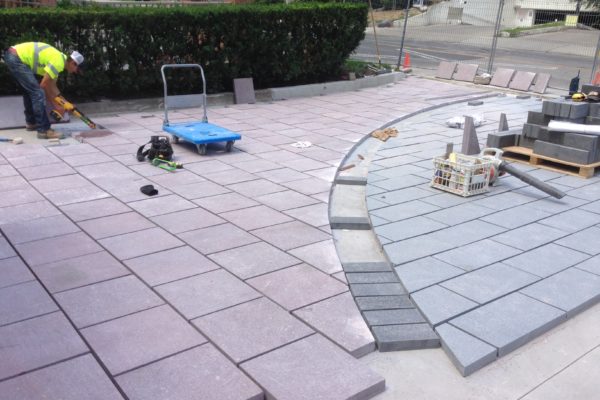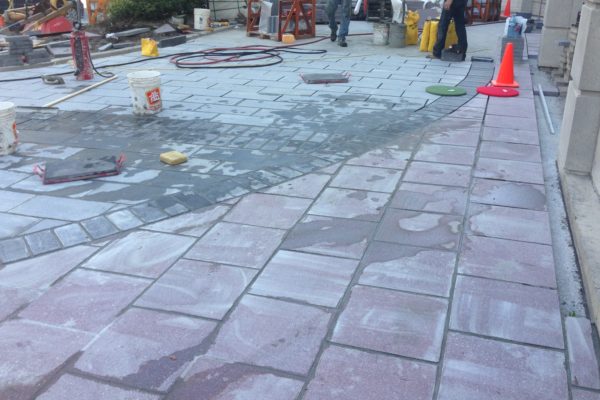This article has been published in the Condominium Manager Magazine summer 2017 issue! You can read it in the online magazine here, or directly download the PDF version.
Money spent on the best landscape design and best stones will be wasted if the brand-new driveway shows wear after just a few years. Especially if it needs to be re-done again within the Owners’ memory! Good engineering design saves your money.
A well designed and durable entrance driveway significantly increases the curb appeal of any home. Take the example of a condominium, where many people use and see the entranceway. The driveway welcomes people to the building, directs vehicles and pedestrians, and sets up visitors to enjoy their arrival and departure.
Rome was famous for its roadway network. Wikipedia tells us that “At the peak of Rome’s development, no fewer than 29 great military highways radiated from the capital, and the late Empire’s 113 provinces were interconnected by 372 great roads. The whole comprised more than 400,000 kilometres (250,000 miles) of roads, of which over 80,500 kilometres (50,000 mi) were stone-paved.” This is an incredible amount of construction! They must have had methods that worked.
Not only are the roads legendary, many survive to this day. However, most are likely below current roadways, serving as durable bases. The roads were designed for durability, because no one wants to perform construction maintenance by hand, more frequently than necessary.
Their construction process:
- dig down to hard surface (preferably bedrock)
- pack gravel backfill
- overlay with a rubble concrete made of stones: ceramic and lime; fine concrete using crushed ceramic and lime
- lay the roadbed
- use large stones set in pozzolanic concrete
The durability comes from the entirety of the construction. The roads were graded to promote drainage and often had ditches and methods to control water. They had curbs to control erosion. The road surface was tightly laid and sealed with concrete and was supported on a firm base that was also water resistant. This sat on a drainage layer that would accommodate groundwater and freeze-thaw effects. Since this layer was overlain by concrete, fine sand would not wash from the roadway above and clog the gravel bed.
Roman concrete was also unique as it relied heavily on pozzolans, which are by-products of volcanic activity. Pozzolanic concrete has a much lower heat of hydration than modern Portland cement concretes, meaning there is less heat given off as it sets. This means that there is less expansion due to the heat, and therefore less micro cracking. Therefore, Pozzolanic concrete is also less permeable than Portland concretes. In fact, pozzolans such as fly ash are used to improve modern concrete’s resistance to chloride penetration, due to the reduced permeability.
The Romans also used pozzolanic concrete for their floors – to lay their travertine tiles, much like we do today. Interestingly, the Colosseum in Rome is constructed almost entirely out of travertine. Fun fact: Travertine’s Latin name is Lapis Tiburtinus, meaning Tibur stone, for the ancient Roman city where it was quarried, which is now known as Tivoli. This pozzolanic concrete was very durable due to the reduced micro-cracking and permeability.
Another secret to Roman durability is climate. Those roads did not experience the effects of a -35oC Canadian winter, or Southern Ontario’s freeze-thaw cycles.
So, what can we learn from the Romans?
- solid base
- drainage layer, sealed in (typically using filter fabric)
- concrete base
- paved surface with durable joint mortar
This makes sense, and underpins good driveway design. However, there is a critical difference: In Canada, the harsh winters present another challenge with de-icing efforts (salt, chemicals, heat) and deep freeze thaw cycles. This cycling has the effect of inducing cracking in the driveway surfaces, as they move due to the significant differences in temperature between summer and winter in Canada, and often on a daily basis. Once cracks are present, water sitting in those cracks freezes and furthers damage, around the cracks. Water that gets below a paved surface will expand up to ten times when it freezes, heaving surfaces, even when placed on concrete substrates.
The trick then, is to manage the water and not allow it below the finished surface. Proper slopes for drainage are a necessity – and those drains must be kept clear. It is critical for long term durability that water cannot get below a paved surface. This is especially true of a stone or tiled surface, where the stones can become loose, creating tripping hazards. It is therefore important to control overall cracking of the driveway itself, by understanding and providing for the thermal movements caused by the seasons.
It is important to control the cracking of the joints in the paved surface, by selecting a high performance grout material and ensuring it is properly installed and cured. In order to limit moisture under the stones, possibly between the stones and a concrete bed, an adhesive can be used instead of a mortar. The adhesive is applied in a continuous bed, which does not allow any gaps under the stone, by back-buttering the stone prior to laying into the adhesive that has been troweled onto the concrete.
Case Study: 11 storey condominium in mid-town Toronto
The main entrance driveway paving stones were showing signs of wear after eight years of use. The building experienced sinkholes along the edge of the garage roof slab due to deteriorating formwork left in the ground after construction. The sinkholes were of particular concern under the main entrance driveway. Although about 70% of the driveway was on the garage roof slab, a significant section of the driveway was directly over the edge of the roof slab and the sinkholes. Ongoing efforts to fill sinkholes were not satisfactory. The Board agreed that a concrete slab should be installed below the new paving surface. The concrete slab was designed to cantilever over the edge of the garage roof slab in the event any future sinkholes appeared.
However, as in ancient Rome, the first improvement was to dig down to expose the sinkhole and fill to solid using compacted gravel. Lean concrete was installed along the edge of the roof slab as a “plug”, prior to installation of the new concrete slab. This concrete slab was poured in sections, the two ends and middle of the curved driveway were first, and the middle sections last. Glass Fibre Reinforced Polymer (GFRP) reinforcing bars were placed across the pour joints and were also used to reinforce the cantilever. Since the driveway would be subject to de-icing salts the GFRP bars will not corrode as steel bars would. The concrete was reinforced with polymer fibres at a rate that optimized the bending strength of the slab. The concrete was a non-shrink mix, and was continuously wet cured with burlap for at least four days. Prior to laying the stone, there was not one crack, despite being poured in August.
The granite paving stones, sourced from China, were installed starting at one end by first ensuring they would be level using small neoprene shims. They were then back buttered, and laid in a solid bed of adhesive. The adhesive was not troweled like normal toothed trowelled tiles. Instead, it was installed as a solid, moisture resistant layer which provides continuous support for the paving stone. The joints in the stone were filled with high performance (non-shrink) grout.
The driveway has performed well over the first winter. It has added significant curb appeal to the building and is one of the first projects in Toronto, installed using the adhesive method.
Whether the driveway survives to the next millennia remains to be seen!




Today, the most common pavement to use in a driveway installation is asphalt. This is the same material city streets and commercial parking lots are made of. What kind of statement does asphalt make? Is your asphalt driveway in good repair without any sign of cracks? If it is, how long will it stay that way?
Thanks for commenting Jetserge.
Asphalt deteriorates over time as the petroleum based binders break down. Good subgrade will ensure the longest life, but the best subgrade will not prevent asphalt from breaking down. A discussion on asphalt issues and their causes is a whole other article! But yes, premature cracking of an asphalt driveway indicates poor base preparation.